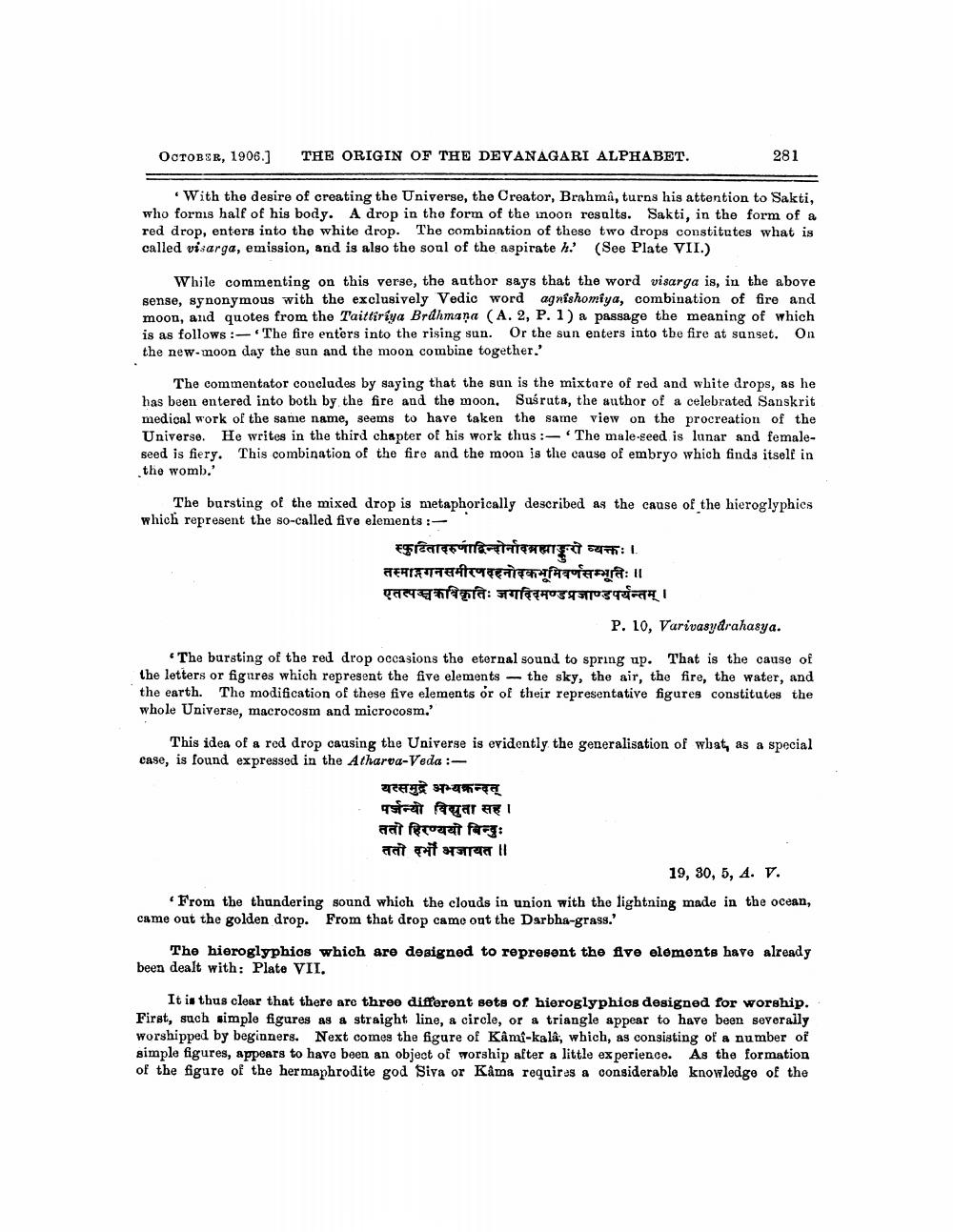________________
OCTOBER, 1906.)
THE ORIGIN OF THE DEVANAGARI ALPHABET.
281
With the desire of creating the Universe, the Creator, Brahma, turns his attention to Sakti, who fornis half of his body. A drop in the form of the moon results. Sakti, in the form of a red drop, enters into the white drop. The combination of these two drops constitutes what is called visarga, emission, and is also the soul of the aspirate h. (See Plate VII.)
While commenting on this verse, the author says that the word visarga is, in the above sense, synonymous with the exclusively Vedic word agnishomiya, combination of fire and moon, and quotes from the Taittiriya Brdhmaņa (A. 2, P. 1) a passage the meaning of which is as follows:- The fire enters into the rising sun. Or the sun enters into the fire at sanset. On the new-moon day the sun and the moon combine together.'
The commentator concludes by saying that the sun is the mixtare of red and white drops, as he has been entered into both by the fire and the moon, Susruta, the author of a celebrated Sanskrit medical work of the same name, seems to have taken the same view on the procreation of the Universe. He writes in the third chapter of his work thus :- 'The male-seed is lunar and femaleseed is fiery. This combination of the fire and the moon is the cause of embryo which finds itself in the womb.'
The bursting of the mixed drop is metaphorically described as the cause of the hieroglyphics which represent the so-called five elements :
स्फुटितावरुणादिन्दोर्नादब्रह्माकुरो व्यक्तः। तस्मागगनसमीरणदहनोदकभूमिवर्णसम्भूतिः ।। एतत्पञ्चकविकृतिः जगदिदमण्डप्रजाण्डपर्यन्तम् ।
P. 10, Varivasydrahasya.
• The bursting of the red drop occasions the eternal sound to spring up. That is the cause of the letters or figures which represent the five elements - the sky, the air, the fire, the water, and the earth. The modification of these five elements or of their representative figures constitutes the whole Universe, macrocosm and microcosm.'
This idea of a red drop causing the Universe is evidently the generalisation of what, as a special case, is found expressed in the Atharva-Veda :
यत्समुद्रे अभ्यक्रन्दत् पर्जन्यो विद्युता सह । ततो हिरण्ययो बिन्दु ततो दी अजायत ।।
19, 30, 5, 4. V. From the thundering sound which the clouds in union with the lightning made in the ocean, came out the golden drop. From that drop came out the Darbha-grass.'
The hieroglyphios which are designed to represent the five elements have already been dealt with: Plate VII.
It is thus clear that there are three different sets of hieroglyphics designed for worship. First, such simple figures as a straight line, & circle, or a triangle appear to have been severaily worshipped by beginners. Next comes the figure of Kâmi-kala, which, as consisting of a number of simple figures, appears to have been an object of worship after a little experience. As the formation of the figure of the hermaphrodite god Siva or Kama requires a considerable knowledge of the




